church in the middle ages of europe.pptx
Download as PPTX, PDF0 likes39 views
church in middle edge
1 of 8
Download to read offline

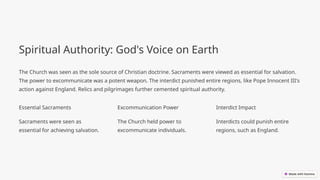

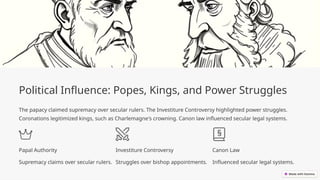
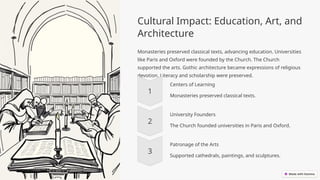
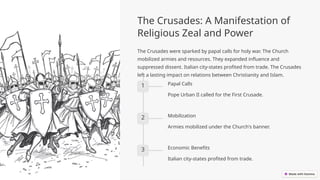
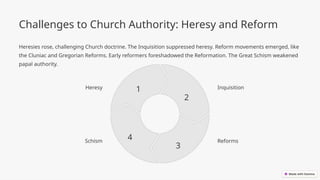
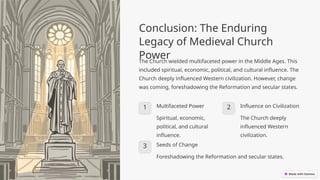
Ad
Recommended
The Medieval Church Concepts for high school
The Medieval Church Concepts for high schoolAriannaMoreno10
?
The document provides an overview of the medieval church's historical significance from the fall of the Western Roman Empire to the Renaissance. It discusses key developments including the rise of monasticism, the papacy's authority, the Crusades, scholasticism, and notable heretical movements. It also highlights the challenges faced by the church during events such as the Avignon Papacy, the Great Schism, and the Black Death.MIDDLE AGES.pptx just sharing.sdsdsdsdsd
MIDDLE AGES.pptx just sharing.sdsdsdsdsdbeatrizeperea1
?
During the Middle Ages, the Roman Catholic Church became a unifying institution in Western Europe as it filled the void left by the decline of Roman authority, serving social, political, and religious needs. The church's structure included various ranks, with the Pope at the top, and it played a significant role in education and the preservation of Greco-Roman culture through monasteries. However, the church faced corruption issues, including the sale of church positions and the abuse of power during the Inquisition.The Middle Ages Part 1 and The Church unifies.ppt
The Middle Ages Part 1 and The Church unifies.pptRestyHezronDamaso1
?
The Church played a major role in stabilizing Western Europe after the fall of the Roman Empire. As political authority dissolved, the Church provided order, security, and spiritual leadership that people relied upon. It became one of the most powerful institutions through its wealth acquired from tithes, large land holdings, and political influence over rulers through powers like excommunication. The Church helped to unify the fragmented peoples under its religious authority.Catholic Church In Medieval Europe
Catholic Church In Medieval EuropeLaurissa Agosta
?
The Catholic Church was the most powerful organization in medieval Europe. It claimed authority over both religious and secular matters. The Church's power came from its role as a representative of God, its integration into daily life, and its ability to determine salvation or damnation through excommunication. Over time, the Church grew wealthy through donations and inheritance of land, and preserved learning through clergy who were literate in Latin. However, corruption grew as the Church's wealth and power increased.Religious influences on western political thought
Religious influences on western political thoughtkrobinette
?
The document discusses the influence of various religions on Western political development. It describes how Judaism introduced monotheism and ideas like individual worth that contributed to democracy. Christianity built on Jewish principles like the Golden Rule and equality. Islam also taught moral and ethical values as well as opposition to injustice. During the Middle Ages, Renaissance, Reformation, emphasis shifted from the Church to the individual. The Reformation especially encouraged independent thought and weakened the Catholic Church's authority, influencing political and social change.7.37 spreading christianity
7.37 spreading christianityJean Provine
?
Christianity spread north of the Alps after the fall of the Western Roman Empire through the efforts of the early church and monasteries. The early church established parishes across Europe led by priests who provided religious instruction and other services to local communities. Monasteries also helped spread Christianity by serving as centers of education, healthcare, and preserving knowledge, while developing new agricultural techniques. Together, the church and monasteries played key roles in the diffusion of Christianity throughout Europe following the collapse of Roman authority.The Medieval Catholic Church article
The Medieval Catholic Church articleClaire James
?
The Medieval Catholic Church played a major role in medieval Europe. The Church became very rich and powerful through tithes from the people and payments for sacraments. Local churches were the center of town life, and the largest churches were cathedrals where bishops were headquartered. Gothic architecture developed in the 12th century allowing cathedrals to have thinner walls and taller windows.Church in the Early Middle Ages
Church in the Early Middle Agesjauntingjen
?
The Roman Catholic Church grew in importance and became the central unifying institution in Western Europe after the fall of the Roman Empire. The Church spread Christianity through missionary work, brought Roman culture to Germanic tribes, and served important social, political, and religious roles for people during the Middle Ages. Church scholars in monasteries preserved classical literature and laid the foundations for later universities in Europe.World History Ch. 13 Section 5 Notes
World History Ch. 13 Section 5 Notesskorbar7
?
The document discusses the growth of power of the Catholic Church during the Middle Ages in Europe. It describes how various reforms strengthened the papacy's authority, such as Pope Leo IX's efforts in the 11th century to eliminate corruption among clergy. This brought the papacy into conflict with political rulers over the appointment of bishops. A key event was the dispute between Pope Gregory VII and Holy Roman Emperor Henry IV, where the pope excommunicated the emperor, asserting the church's independence. Monasticism also saw changes as new orders like the Cistercians embraced more austere lifestyles.The middle ages
The middle agesarleneinbaytown
?
The document summarizes several key aspects of life in medieval Europe during the Middle Ages, including the fall of the Western Roman Empire and the rise of the Byzantine Empire; the development of feudalism and manorialism; the power and influence of the Catholic Church; major events like the Crusades, Black Death, and Hundred Years War; and the introduction of new ideas, technologies, and crops from other parts of the world.Christianity ppt
Christianity pptHST130mcc
?
During the Middle Ages in Europe, Christianity developed and spread in the following ways:
The Council of Nicea in 325 AD established the basic tenets of Christianity. Emperor Constantine moved the capital of the Roman Empire to Constantinople and missionaries spread Christianity throughout Europe. Emperor Justinian constructed churches throughout the Byzantine Empire, showing the close connection between church and state. The Church grew powerful in Medieval Europe and became a central, unifying force as Charlemagne was crowned emperor by the Pope. However, a Great Schism in 1054 AD divided Christianity into Western Roman Catholicism and Eastern Orthodoxy.Medieval Europe Lesson 4 - The Catholic Church
Medieval Europe Lesson 4 - The Catholic ChurchLyricus
?
The Catholic Church was the only organization that provided unity and identity in Europe after the Fall of the Roman Empire. It viewed itself as the guardian of Christianity. During the Middle Ages, salvation was the most important thing. St. Benedict created monastic communities that helped heal chaos. Monasteries preserved writings by copying in scriptoriums and illuminated art. They created schools and the first university developed at Notre Dame Cathedral. The Franciscan Order served the poor while the Dominican Order focused on teaching Christianity.Middle Ages
Middle AgesAMSimpson
?
The document summarizes key aspects of life in medieval Europe during the Middle Ages. It describes how the fall of the Roman Empire led to the rise of feudalism and manorialism as people organized into local communities centered around lords for protection. The Middle Ages saw developments like the growth of the Catholic Church's power, the Crusades between Christians and Muslims, and technological innovations including eyeglasses, mechanical clocks, gunpowder, and advances in metalworking.Rewriting The Middle Ages In The Twentieth Century Iii Political Theory And P...
Rewriting The Middle Ages In The Twentieth Century Iii Political Theory And P...nyilasdoukeu
?
Rewriting The Middle Ages In The Twentieth Century Iii Political Theory And Practice Julia Pavn Benito
Rewriting The Middle Ages In The Twentieth Century Iii Political Theory And Practice Julia Pavn Benito
Rewriting The Middle Ages In The Twentieth Century Iii Political Theory And Practice Julia Pavn BenitoThe Medieval Church
The Medieval Churchguestff043e
?
The medieval church established papal supremacy with popes believing they had more power than kings. Excommunication from the church was a severe punishment, preventing people from receiving sacraments or Christian burial. The church was important socially and politically, with priests providing people's only connection to the institution and rituals being integrated into daily life. Monks and nuns helped spread Christianity in Europe by copying writings, providing social services like education and healthcare, and emphasizing hard work.The Medieval Church
The Medieval Churchguestff043e
?
The medieval church established papal supremacy with popes believing they had more power than kings. Excommunication from the church was a severe punishment, preventing people from receiving sacraments or Christian burial. The church was important socially and politically, with priests providing people's only connection to the institution and rituals being integrated into daily life. Monks and nuns helped spread Christianity in Europe by copying writings, providing social services like education and healthcare, and emphasizing hard work.6.3.4
6.3.4dkam136
?
The document outlines an agenda for a history class lesson on the Crusades and medieval Europe. It includes directions for different student roles to prepare materials, the lesson objectives which are to review European geography, understand the Crusades, and learn about religious society. The content will cover the Crusades and related topics like religious orders and architecture.6.3.4
6.3.4dkam136
?
The document outlines an in-class lesson plan on the Crusades and medieval Europe. It includes directions for different student roles, an agenda with learning objectives, maps of European countries, information on the Crusades, and questions to facilitate discussion.The Role of the Medieval Church
The Role of the Medieval Churchmrsfitzss
?
The Catholic Church played a central role in medieval European society. It provided religious services and sacraments, operated monasteries and universities, and was closely tied to political systems as many church officials also held government roles. The Pope headed the church hierarchy and claimed authority over all kings and emperors. This gave the Church tremendous power in the Middle Ages as it was the most powerful institution. However, as monarchies grew stronger they began contesting the Church's authority, leading to tensions over who had supremacy in religious and political matters - the Pope or secular rulers. This caused conflicts between the Catholic Church and monarchies throughout the medieval period.Those Who Pray,Kill,and Work
Those Who Pray,Kill,and WorkMicaelaD2
?
The document discusses the role and power of the Catholic Church during medieval feudal Europe. It describes the three estates of society - the clergy (First Estate), nobility (Second Estate), and peasants (Third Estate). The Church had extraordinary power over ordinary people, deciding salvation and requiring tithes. Over time, the clergy became corrupt and more focused on wealth and prestige than spiritual guidance, weakening the Church. The Crusades were a series of wars called by the Church from the 11th-13th centuries in an attempt to retake the Holy Land from Muslim rule, but ultimately failed.The Medieval Catholic Church
The Medieval Catholic ChurchClaire James
?
Here are the answers to your questions:
1. Catholic Mass is the weekly ritual service in the Catholic Church where Communion is taken. It commemorates Jesus's death and sacrifice on the cross.
2. The building monks live in is called a monastery.
3. One example of power the Catholic Church had was that it could excommunicate people, essentially kicking them out of the Church and preventing them from receiving sacraments and going to heaven.
4. One of the Catholic reform movements was the Friars in the 1200s. Friars were wandering preachers that lived among common people to encourage reform and preach the gospel.7.39 importance of catholic church
7.39 importance of catholic churchJean Provine
?
The Catholic Church was a central institution in medieval Europe, influencing politics, education, and the arts. It played a key role in shaping society, establishing the first universities, and promoting religious orders while also becoming a major landholder and political power. Additionally, the church inspired the development of Gothic architecture and enriched the cultural landscape through religious art and literature.Lecture outlines mc kayworld10e ch14
Lecture outlines mc kayworld10e ch14kpetersen2
?
The document summarizes key political, social, and economic developments in Europe during the Middle Ages, from 800-1450 CE. It describes how Charlemagne's empire fragmented after his death, leading to the rise of feudalism and manorialism across Europe. It also discusses the invasions by Vikings, Magyars, and Muslims during this period. The document outlines the growth of centralized monarchies in places like England and France, as well as increased papal power and reforms within the Catholic Church. Other topics covered include the Crusades, expansion of trade and rise of cities, developments in education and architecture, and crises like the Black Death in the 14th century.Ascendance of Catholic Csssssssssssshurch.ppt
Ascendance of Catholic Csssssssssssshurch.pptRestyHezronDamaso1
?
The document discusses the significant role of the Catholic Church in medieval Europe, highlighting its influence on the lives of people and monarchies. It outlines the church's organizational structure, with the pope at the top, and describes its wealth and political power that often surpassed individual monarchs', fostering strong ties with them. Additionally, it touches on the church's history, including its appeal to the poor and its conflicts with the Roman Empire.Middle ages
Middle agessergio.historia
?
The document provides an overview of life in medieval Europe between the 5th and 15th centuries. It describes this era as complex and vibrant, not a "dark age" as previously portrayed. Key developments included the rise of the Catholic Church as the most powerful institution, the expansion of Islam and its contributions to science, and the Crusades launched by the Church. Architecture like Romanesque and Gothic cathedrals expressed religious devotion, while feudal systems and growing trade in cities began transforming rural economies and societies. An outbreak of plague in the 14th century killed around 30% of Europe's population and helped usher in the Renaissance.Church in middle ages
Church in middle agesMurdock34
?
The Catholic Church was the dominant institution in Europe during the Middle Ages and wielded significant political power. Bishops and other high-ranking clergy often sat on kings' councils and helped govern. Monasteries were run according to St. Benedict's rules, with monks and nuns taking vows of poverty, chastery, and obedience. Pilgrimages to holy sites were also an important part of religious life. The Crusades were a series of wars between 1095 and 1291 where Christians fought to regain the Holy Land from Muslim rule.Church in middle ages
Church in middle agesMurdock34
?
The Catholic Church was the dominant institution in Europe during the Middle Ages and wielded significant political power. Bishops and other high-ranking clergy often sat on royal councils and helped govern territories. Monasteries were run by strict rules and provided services to communities, while pilgrimages to holy sites were an important part of religious life. Knights formed an elite military class that fought for lords and kings in exchange for land and wealth, though some later paid to avoid military service. The Crusades were a series of wars launched by the Pope between Christians and Muslims over control of holy sites in Jerusalem, while the Inquisition was established to root out heresy.Church in middle ages
Church in middle agesMurdock34
?
The Catholic Church was the dominant institution in Europe during the Middle Ages and wielded significant political power. Bishops and other high-ranking clergy often sat on kings' councils and helped govern. Monasteries were run according to St. Benedict's rules, with monks and nuns taking vows of poverty, chastery, and obedience. Pilgrimages to holy sites were also an important part of religious life. The Crusades were a series of wars between Christians and Muslims over control of holy sites in Palestine. In response to heresy, the Inquisition was established in 1233 to investigate and punish those accused of holding beliefs contrary to Church doctrine.最新版美国天普大学毕业证(罢别尘辫濒别毕业证书)原版定制
最新版美国天普大学毕业证(罢别尘辫濒别毕业证书)原版定制Taqyea
?
鉴于此,定制天普大学学位证书提升履历【q薇1954292140】原版高仿天普大学毕业证(Temple毕业证书)可先看成品样本【q薇1954292140】帮您解决在美国天普大学未毕业难题,美国毕业证购买,美国文凭购买,【q微1954292140】美国文凭购买,美国文凭定制,美国文凭补办。专业在线定制美国大学文凭,定做美国本科文凭,【q微1954292140】复制美国Temple University completion letter。在线快速补办美国本科毕业证、硕士文凭证书,购买美国学位证、天普大学Offer,美国大学文凭在线购买。
如果您处于以下几种情况:
◇在校期间,因各种原因未能顺利毕业……拿不到官方毕业证
◇面对父母的压力,希望尽快拿到;
◇不清楚认证流程以及材料该如何准备;
◇回国时间很长,忘记办理;
◇回国马上就要找工作,办给用人单位看;
◇企事业单位必须要求办理的
◇需要报考公务员、购买免税车、落转户口
◇申请留学生创业基金
【复刻一套天普大学毕业证成绩单信封等材料最强攻略,Buy Temple University Transcripts】
购买日韩成绩单、英国大学成绩单、美国大学成绩单、澳洲大学成绩单、加拿大大学成绩单(q微1954292140)新加坡大学成绩单、新西兰大学成绩单、爱尔兰成绩单、西班牙成绩单、德国成绩单。成绩单的意义主要体现在证明学习能力、评估学术背景、展示综合素质、提高录取率,以及是作为留信认证申请材料的一部分。
天普大学成绩单能够体现您的的学习能力,包括天普大学课程成绩、专业能力、研究能力。(q微1954292140)具体来说,成绩报告单通常包含学生的学习技能与习惯、各科成绩以及老师评语等部分,因此,成绩单不仅是学生学术能力的证明,也是评估学生是否适合某个教育项目的重要依据!More Related Content
Similar to church in the middle ages of europe.pptx (20)
World History Ch. 13 Section 5 Notes
World History Ch. 13 Section 5 Notesskorbar7
?
The document discusses the growth of power of the Catholic Church during the Middle Ages in Europe. It describes how various reforms strengthened the papacy's authority, such as Pope Leo IX's efforts in the 11th century to eliminate corruption among clergy. This brought the papacy into conflict with political rulers over the appointment of bishops. A key event was the dispute between Pope Gregory VII and Holy Roman Emperor Henry IV, where the pope excommunicated the emperor, asserting the church's independence. Monasticism also saw changes as new orders like the Cistercians embraced more austere lifestyles.The middle ages
The middle agesarleneinbaytown
?
The document summarizes several key aspects of life in medieval Europe during the Middle Ages, including the fall of the Western Roman Empire and the rise of the Byzantine Empire; the development of feudalism and manorialism; the power and influence of the Catholic Church; major events like the Crusades, Black Death, and Hundred Years War; and the introduction of new ideas, technologies, and crops from other parts of the world.Christianity ppt
Christianity pptHST130mcc
?
During the Middle Ages in Europe, Christianity developed and spread in the following ways:
The Council of Nicea in 325 AD established the basic tenets of Christianity. Emperor Constantine moved the capital of the Roman Empire to Constantinople and missionaries spread Christianity throughout Europe. Emperor Justinian constructed churches throughout the Byzantine Empire, showing the close connection between church and state. The Church grew powerful in Medieval Europe and became a central, unifying force as Charlemagne was crowned emperor by the Pope. However, a Great Schism in 1054 AD divided Christianity into Western Roman Catholicism and Eastern Orthodoxy.Medieval Europe Lesson 4 - The Catholic Church
Medieval Europe Lesson 4 - The Catholic ChurchLyricus
?
The Catholic Church was the only organization that provided unity and identity in Europe after the Fall of the Roman Empire. It viewed itself as the guardian of Christianity. During the Middle Ages, salvation was the most important thing. St. Benedict created monastic communities that helped heal chaos. Monasteries preserved writings by copying in scriptoriums and illuminated art. They created schools and the first university developed at Notre Dame Cathedral. The Franciscan Order served the poor while the Dominican Order focused on teaching Christianity.Middle Ages
Middle AgesAMSimpson
?
The document summarizes key aspects of life in medieval Europe during the Middle Ages. It describes how the fall of the Roman Empire led to the rise of feudalism and manorialism as people organized into local communities centered around lords for protection. The Middle Ages saw developments like the growth of the Catholic Church's power, the Crusades between Christians and Muslims, and technological innovations including eyeglasses, mechanical clocks, gunpowder, and advances in metalworking.Rewriting The Middle Ages In The Twentieth Century Iii Political Theory And P...
Rewriting The Middle Ages In The Twentieth Century Iii Political Theory And P...nyilasdoukeu
?
Rewriting The Middle Ages In The Twentieth Century Iii Political Theory And Practice Julia Pavn Benito
Rewriting The Middle Ages In The Twentieth Century Iii Political Theory And Practice Julia Pavn Benito
Rewriting The Middle Ages In The Twentieth Century Iii Political Theory And Practice Julia Pavn BenitoThe Medieval Church
The Medieval Churchguestff043e
?
The medieval church established papal supremacy with popes believing they had more power than kings. Excommunication from the church was a severe punishment, preventing people from receiving sacraments or Christian burial. The church was important socially and politically, with priests providing people's only connection to the institution and rituals being integrated into daily life. Monks and nuns helped spread Christianity in Europe by copying writings, providing social services like education and healthcare, and emphasizing hard work.The Medieval Church
The Medieval Churchguestff043e
?
The medieval church established papal supremacy with popes believing they had more power than kings. Excommunication from the church was a severe punishment, preventing people from receiving sacraments or Christian burial. The church was important socially and politically, with priests providing people's only connection to the institution and rituals being integrated into daily life. Monks and nuns helped spread Christianity in Europe by copying writings, providing social services like education and healthcare, and emphasizing hard work.6.3.4
6.3.4dkam136
?
The document outlines an agenda for a history class lesson on the Crusades and medieval Europe. It includes directions for different student roles to prepare materials, the lesson objectives which are to review European geography, understand the Crusades, and learn about religious society. The content will cover the Crusades and related topics like religious orders and architecture.6.3.4
6.3.4dkam136
?
The document outlines an in-class lesson plan on the Crusades and medieval Europe. It includes directions for different student roles, an agenda with learning objectives, maps of European countries, information on the Crusades, and questions to facilitate discussion.The Role of the Medieval Church
The Role of the Medieval Churchmrsfitzss
?
The Catholic Church played a central role in medieval European society. It provided religious services and sacraments, operated monasteries and universities, and was closely tied to political systems as many church officials also held government roles. The Pope headed the church hierarchy and claimed authority over all kings and emperors. This gave the Church tremendous power in the Middle Ages as it was the most powerful institution. However, as monarchies grew stronger they began contesting the Church's authority, leading to tensions over who had supremacy in religious and political matters - the Pope or secular rulers. This caused conflicts between the Catholic Church and monarchies throughout the medieval period.Those Who Pray,Kill,and Work
Those Who Pray,Kill,and WorkMicaelaD2
?
The document discusses the role and power of the Catholic Church during medieval feudal Europe. It describes the three estates of society - the clergy (First Estate), nobility (Second Estate), and peasants (Third Estate). The Church had extraordinary power over ordinary people, deciding salvation and requiring tithes. Over time, the clergy became corrupt and more focused on wealth and prestige than spiritual guidance, weakening the Church. The Crusades were a series of wars called by the Church from the 11th-13th centuries in an attempt to retake the Holy Land from Muslim rule, but ultimately failed.The Medieval Catholic Church
The Medieval Catholic ChurchClaire James
?
Here are the answers to your questions:
1. Catholic Mass is the weekly ritual service in the Catholic Church where Communion is taken. It commemorates Jesus's death and sacrifice on the cross.
2. The building monks live in is called a monastery.
3. One example of power the Catholic Church had was that it could excommunicate people, essentially kicking them out of the Church and preventing them from receiving sacraments and going to heaven.
4. One of the Catholic reform movements was the Friars in the 1200s. Friars were wandering preachers that lived among common people to encourage reform and preach the gospel.7.39 importance of catholic church
7.39 importance of catholic churchJean Provine
?
The Catholic Church was a central institution in medieval Europe, influencing politics, education, and the arts. It played a key role in shaping society, establishing the first universities, and promoting religious orders while also becoming a major landholder and political power. Additionally, the church inspired the development of Gothic architecture and enriched the cultural landscape through religious art and literature.Lecture outlines mc kayworld10e ch14
Lecture outlines mc kayworld10e ch14kpetersen2
?
The document summarizes key political, social, and economic developments in Europe during the Middle Ages, from 800-1450 CE. It describes how Charlemagne's empire fragmented after his death, leading to the rise of feudalism and manorialism across Europe. It also discusses the invasions by Vikings, Magyars, and Muslims during this period. The document outlines the growth of centralized monarchies in places like England and France, as well as increased papal power and reforms within the Catholic Church. Other topics covered include the Crusades, expansion of trade and rise of cities, developments in education and architecture, and crises like the Black Death in the 14th century.Ascendance of Catholic Csssssssssssshurch.ppt
Ascendance of Catholic Csssssssssssshurch.pptRestyHezronDamaso1
?
The document discusses the significant role of the Catholic Church in medieval Europe, highlighting its influence on the lives of people and monarchies. It outlines the church's organizational structure, with the pope at the top, and describes its wealth and political power that often surpassed individual monarchs', fostering strong ties with them. Additionally, it touches on the church's history, including its appeal to the poor and its conflicts with the Roman Empire.Middle ages
Middle agessergio.historia
?
The document provides an overview of life in medieval Europe between the 5th and 15th centuries. It describes this era as complex and vibrant, not a "dark age" as previously portrayed. Key developments included the rise of the Catholic Church as the most powerful institution, the expansion of Islam and its contributions to science, and the Crusades launched by the Church. Architecture like Romanesque and Gothic cathedrals expressed religious devotion, while feudal systems and growing trade in cities began transforming rural economies and societies. An outbreak of plague in the 14th century killed around 30% of Europe's population and helped usher in the Renaissance.Church in middle ages
Church in middle agesMurdock34
?
The Catholic Church was the dominant institution in Europe during the Middle Ages and wielded significant political power. Bishops and other high-ranking clergy often sat on kings' councils and helped govern. Monasteries were run according to St. Benedict's rules, with monks and nuns taking vows of poverty, chastery, and obedience. Pilgrimages to holy sites were also an important part of religious life. The Crusades were a series of wars between 1095 and 1291 where Christians fought to regain the Holy Land from Muslim rule.Church in middle ages
Church in middle agesMurdock34
?
The Catholic Church was the dominant institution in Europe during the Middle Ages and wielded significant political power. Bishops and other high-ranking clergy often sat on royal councils and helped govern territories. Monasteries were run by strict rules and provided services to communities, while pilgrimages to holy sites were an important part of religious life. Knights formed an elite military class that fought for lords and kings in exchange for land and wealth, though some later paid to avoid military service. The Crusades were a series of wars launched by the Pope between Christians and Muslims over control of holy sites in Jerusalem, while the Inquisition was established to root out heresy.Church in middle ages
Church in middle agesMurdock34
?
The Catholic Church was the dominant institution in Europe during the Middle Ages and wielded significant political power. Bishops and other high-ranking clergy often sat on kings' councils and helped govern. Monasteries were run according to St. Benedict's rules, with monks and nuns taking vows of poverty, chastery, and obedience. Pilgrimages to holy sites were also an important part of religious life. The Crusades were a series of wars between Christians and Muslims over control of holy sites in Palestine. In response to heresy, the Inquisition was established in 1233 to investigate and punish those accused of holding beliefs contrary to Church doctrine.Recently uploaded (20)
最新版美国天普大学毕业证(罢别尘辫濒别毕业证书)原版定制
最新版美国天普大学毕业证(罢别尘辫濒别毕业证书)原版定制Taqyea
?
鉴于此,定制天普大学学位证书提升履历【q薇1954292140】原版高仿天普大学毕业证(Temple毕业证书)可先看成品样本【q薇1954292140】帮您解决在美国天普大学未毕业难题,美国毕业证购买,美国文凭购买,【q微1954292140】美国文凭购买,美国文凭定制,美国文凭补办。专业在线定制美国大学文凭,定做美国本科文凭,【q微1954292140】复制美国Temple University completion letter。在线快速补办美国本科毕业证、硕士文凭证书,购买美国学位证、天普大学Offer,美国大学文凭在线购买。
如果您处于以下几种情况:
◇在校期间,因各种原因未能顺利毕业……拿不到官方毕业证
◇面对父母的压力,希望尽快拿到;
◇不清楚认证流程以及材料该如何准备;
◇回国时间很长,忘记办理;
◇回国马上就要找工作,办给用人单位看;
◇企事业单位必须要求办理的
◇需要报考公务员、购买免税车、落转户口
◇申请留学生创业基金
【复刻一套天普大学毕业证成绩单信封等材料最强攻略,Buy Temple University Transcripts】
购买日韩成绩单、英国大学成绩单、美国大学成绩单、澳洲大学成绩单、加拿大大学成绩单(q微1954292140)新加坡大学成绩单、新西兰大学成绩单、爱尔兰成绩单、西班牙成绩单、德国成绩单。成绩单的意义主要体现在证明学习能力、评估学术背景、展示综合素质、提高录取率,以及是作为留信认证申请材料的一部分。
天普大学成绩单能够体现您的的学习能力,包括天普大学课程成绩、专业能力、研究能力。(q微1954292140)具体来说,成绩报告单通常包含学生的学习技能与习惯、各科成绩以及老师评语等部分,因此,成绩单不仅是学生学术能力的证明,也是评估学生是否适合某个教育项目的重要依据!Season 12 _ EP03 - The Coked up Quiz .pdf
Season 12 _ EP03 - The Coked up Quiz .pdfQuiz Club, Indian Institute of Technology, Patna
?
Weekly set conducted as part of season 12.How Enzo Zelocchi Leveraged 28 Million Followers to Build a Global Brand That...
How Enzo Zelocchi Leveraged 28 Million Followers to Build a Global Brand That...Enzo Zelocchi Fan Page
?
In a world dominated by fleeting trends and overnight fame, Enzo Zelocchi stands out as a rare blend of consistency, vision, and authenticity. With over 28 million followers across social media platforms, he hasn’t just built an audience — he’s cultivated a global community that believes in creativity, ambition, and purpose.WHO KILLED ALASKA? #28: Bobby Time - "THE HUNT FOR THE HAND" TRANSCRIPT
WHO KILLED ALASKA? #28: Bobby Time - "THE HUNT FOR THE HAND" TRANSCRIPTOptimistic18
?
What if Bobby Yorke hosted Who Killed Alaska? This is not a hypothetical. Bobby is here to hold our ears hostage up until he can exact revenge, which will happen as soon as he can figure out who he's exacting revenge on, and why. Welcome to the tumultuous world of our favorite earthling alien. Watch your step on your way down the Devil's Throat.Internet Quiz - Prelims || Aditya Shiva Sharma, Druva and Haaziq || Midnight ...
Internet Quiz - Prelims || Aditya Shiva Sharma, Druva and Haaziq || Midnight ...BITS Goa Quiz Club
?
Midnight QuizSeason 12_EP02 - Quiz Quiz Hota Hai.pptx
Season 12_EP02 - Quiz Quiz Hota Hai.pptxQuiz Club, Indian Institute of Technology, Patna
?
Weekly set conducted as part of season 12.Lit Quiz Finals || QM: Shivansh Verma, Dhruba Chatterjee & Suhani Timbadia ||...
Lit Quiz Finals || QM: Shivansh Verma, Dhruba Chatterjee & Suhani Timbadia ||...BITS Goa Quiz Club
?
Literature Quiz Finals最新版美国堪萨斯州立大学毕业证(碍-厂迟补迟别毕业证书)原版定制
最新版美国堪萨斯州立大学毕业证(碍-厂迟补迟别毕业证书)原版定制taqyea
?
一比一还原堪萨斯州立大学毕业证/K-State毕业证书2025原版【q薇1954292140】我们专业办理澳洲大学毕业证成绩单,美国大学毕业证成绩单,英国大学毕业证成绩单,加拿大大学毕业证成绩单,新加坡大学毕业证成绩单,新西兰大学毕业证成绩单,韩国大学毕业证成绩单,日本大学毕业证成绩单。
【复刻一套堪萨斯州立大学毕业证成绩单信封等材料最强攻略,Buy Kansas State University Transcripts】
购买日韩成绩单、英国大学成绩单、美国大学成绩单、澳洲大学成绩单、加拿大大学成绩单(q微1954292140)新加坡大学成绩单、新西兰大学成绩单、爱尔兰成绩单、西班牙成绩单、德国成绩单。成绩单的意义主要体现在证明学习能力、评估学术背景、展示综合素质、提高录取率,以及是作为留信认证申请材料的一部分。
堪萨斯州立大学成绩单能够体现您的的学习能力,包括堪萨斯州立大学课程成绩、专业能力、研究能力。(q微1954292140)具体来说,成绩报告单通常包含学生的学习技能与习惯、各科成绩以及老师评语等部分,因此,成绩单不仅是学生学术能力的证明,也是评估学生是否适合某个教育项目的重要依据!
我们承诺采用的是学校原版纸张(原版纸质、底色、纹路)我们工厂拥有全套进口原装设备,特殊工艺都是采用不同机器制作,仿真度基本可以达到100%,所有成品以及工艺效果都可提前给客户展示,不满意可以根据客户要求进行调整,直到满意为止!
【主营项目】
一、工作未确定,回国需先给父母、亲戚朋友看下文凭的情况,办理毕业证|办理文凭: 买大学毕业证|买大学文凭【q薇1954292140】堪萨斯州立大学学位证明书如何办理申请?
二、回国进私企、外企、自己做生意的情况,这些单位是不查询毕业证真伪的,而且国内没有渠道去查询国外文凭的真假,也不需要提供真实教育部认证。鉴于此,办理美国成绩单堪萨斯州立大学毕业证【q薇1954292140】国外大学毕业证, 文凭办理, 国外文凭办理, 留信网认证
三.材料咨询办理、认证咨询办理请加学历顾问【微信:1954292140】堪萨斯州立大学毕业证购买指大学文凭购买,毕业证办理和文凭办理。学院文凭定制,学校原版文凭补办,扫描件文凭定做,100%文凭复刻。The Conspiracies Quiz || QM: Vagarth Dvivedi || Waves 2024 QuizFest || Midnig...
The Conspiracies Quiz || QM: Vagarth Dvivedi || Waves 2024 QuizFest || Midnig...BITS Goa Quiz Club
?
first every midnight quizRalf Schumacher_ The Shadow and the Spotlight in Formula One.docx
Ralf Schumacher_ The Shadow and the Spotlight in Formula One.docxvoice ofarticle
?
When the conversation turns to the most iconic names in the high-octane world of Formula One, it’s impossible to ignore the Schumacher legacy. While Michael Schumacher’s record-breaking career often takes center stage, his younger brother, Ralf Schumacher, has crafted a compelling and impressive racing story of his own — one that deserves to be told in full. Often introduced in the shadow of his elder sibling, Ralf refused to remain just "Michael's younger brother" for long. Instead, he emerged as a fierce competitor with raw talent, relentless determination, and a deep passion for racing that was evident from a very young age.
Growing up in the motorsport-rich environment of Germany, Ralf Schumacher began his racing journey on the local karting circuits, where he quickly displayed a natural flair for speed and control. It was here that he honed the skills that would one day propel him onto the world stage. Unlike many young drivers who fizzle out before reaching the top, Ralf steadily climbed the ranks, moving from national championships to the international arena with precision and maturity far beyond his years. His early years were marked by countless hours of training, setbacks that tested his resolve, and victories that fueled his ambition.
Mastering-Event-Management-Creating-Unforgettable-Experiences.pdf
Mastering-Event-Management-Creating-Unforgettable-Experiences.pdfMosaic Live
?
Mosaic Live stands as Dubai and Abu Dhabi's premier event
management company, delivering creative and reliable solutions for
businesses and government organizations alike. Retail Store Scavenger Hunt feat. MAD MONK
Retail Store Scavenger Hunt feat. MAD MONKjahudson
?
Retail store scavenger hunt for Mad Monk by Joel Hudson. Season 12 _ EP 01 _ Lieutenant Quiz.pptx
Season 12 _ EP 01 _ Lieutenant Quiz.pptxQuiz Club, Indian Institute of Technology, Patna
?
Weekly quiz conducted as part of season 12"Thug Life" (.2025.) +Fu??Mov?e! Down?oad Fre? ????, ???? ?? & ?????
"Thug Life" (.2025.) +Fu??Mov?e! Down?oad Fre? ????, ???? ?? & ?????Ahsan Khan
?
Copy and Paste ??: https://rebrand.ly/46f082 ?
Copy and Paste ??: https://rebrand.ly/46f082 ?
If the link is not clickable, copy and paste it into the new tab
Thug Life Movie Download Free ????, ???? ?? & ?????Ganimatoonics Finals || QM: Agastya and Nikhil || Quark'25 || BITS Pilani, KK...
Ganimatoonics Finals || QM: Agastya and Nikhil || Quark'25 || BITS Pilani, KK...BITS Goa Quiz Club
?
Quark'25Lit Quiz Prelims || QM: Shivansh Verma, Dhruba Chatterjee & Suhani Timbadia |...
Lit Quiz Prelims || QM: Shivansh Verma, Dhruba Chatterjee & Suhani Timbadia |...BITS Goa Quiz Club
?
Literature QuizHow Enzo Zelocchi Leveraged 28 Million Followers to Build a Global Brand That...
How Enzo Zelocchi Leveraged 28 Million Followers to Build a Global Brand That...Enzo Zelocchi Fan Page
?
Ad
church in the middle ages of europe.pptx
- 1. The Medieval Church: A Colossus of Power The Church in the Middle Ages was a dominant force. It shaped medieval society through its spiritual authority. The Church also exerted economic wealth, political influence, and cultural impact. This power was felt across all levels of society. MB by Mohamed Bassel
- 2. Spiritual Authority: God's Voice on Earth The Church was seen as the sole source of Christian doctrine. Sacraments were viewed as essential for salvation. The power to excommunicate was a potent weapon. The interdict punished entire regions, like Pope Innocent III's action against England. Relics and pilgrimages further cemented spiritual authority. Essential Sacraments Sacraments were seen as essential for achieving salvation. Excommunication Power The Church held power to excommunicate individuals. Interdict Impact Interdicts could punish entire regions, such as England.
- 3. Economic Might: Land, Tithes, and W The Church controlled vast land holdings. Tithes enriched the Church through mandatory giving. Monasteries served as economic centers, boosting agriculture and trade. The Church accumulated wealth through donations and indulgences. Vast Land Ownership Controlled up to 1/3 of the land in Europe. Tithes A 10% tax levied on the population. Monasteries Served as economic centers for agriculture, crafts, and trade.
- 4. Political Influence: Popes, Kings, and Power Struggles The papacy claimed supremacy over secular rulers. The Investiture Controversy highlighted power struggles. Coronations legitimized kings, such as Charlemagne's crowning. Canon law influenced secular legal systems. Papal Authority Supremacy claims over secular rulers. Investiture Controversy Struggles over bishop appointments. Canon Law Influenced secular legal systems.
- 5. Cultural Impact: Education, Art, and Architecture Monasteries preserved classical texts, advancing education. Universities like Paris and Oxford were founded by the Church. The Church supported the arts. Gothic architecture became expressions of religious devotion. Literacy and scholarship were preserved. Centers of Learning Monasteries preserved classical texts. University Founders The Church founded universities in Paris and Oxford. Patronage of the Arts Supported cathedrals, paintings, and sculptures.
- 6. The Crusades: A Manifestation of Religious Zeal and Power The Crusades were sparked by papal calls for holy war. The Church mobilized armies and resources. They expanded influence and suppressed dissent. Italian city-states profited from trade. The Crusades left a lasting impact on relations between Christianity and Islam. 1 Papal Calls Pope Urban II called for the First Crusade. 2 Mobilization Armies mobilized under the Church's banner. 3 Economic Benefits Italian city-states profited from trade.
- 7. Challenges to Church Authority: Heresy and Reform Heresies rose, challenging Church doctrine. The Inquisition suppressed heresy. Reform movements emerged, like the Cluniac and Gregorian Reforms. Early reformers foreshadowed the Reformation. The Great Schism weakened papal authority. Heresy 1 Inquisition 2 Reforms 3 Schism 4
- 8. Conclusion: The Enduring Legacy of Medieval Church Power The Church wielded multifaceted power in the Middle Ages. This included spiritual, economic, political, and cultural influence. The Church deeply influenced Western civilization. However, change was coming, foreshadowing the Reformation and secular states. 1 Multifaceted Power Spiritual, economic, political, and cultural influence. 2 Influence on Civilization The Church deeply influenced Western civilization. 3 Seeds of Change Foreshadowing the Reformation and secular states.